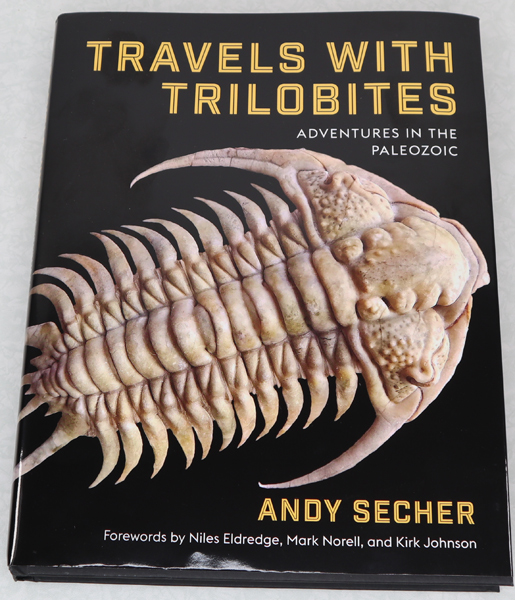Everything Dinosaur team members have had the opportunity to review a new book that documents the evolutionary history of the enigmatic Trilobita. Trilobites evolved during the Cambrian, they are arguably one of the most successful types of animal to have ever lived, with more than 25,000 species named and described to date. Life-long trilobite devotee Andy Secher (American Museum of Natural History, New York), has compiled a comprehensive, and beautifully illustrated book that tells their story, outlines their origins and looks at their amazing variety.

Travels with Trilobites
With forewords by Niles Eldredge, Kirk Johnson and Mark Norell, this book provides a detailed examination of the different genera of trilobites that existed in each geological period, starting with the Class’s evolutionary origins in the Early Cambrian to their eventual demise at the end of the Permian, more than 250 million years later.

Feeding, Moulting and Reproduction
The author, who is also a co-editor of the American Museum of Natural History’s dedicated trilobite website, explores some of the world’s most famous Palaeozoic Lagerstätten including Kangaroo Island off the coast of South Australia, the Burgess Shale (British Columbia), the Chengjiang biota (Yunnan Province, China) and the Valongo Formation of Portugal. He documents the trilobites associated with each of these significant fossil locations and also embellishes the history of the Trilobita by including numerous “rapid reports” from other fossiliferous locations.
Travels with Trilobites examines the biology of these remarkable arthropods with the author outlining the development of trilobite eyes, how they breathed, their moulting behaviour, feeding and reproduction. There is even a small section looking at the trilobite fossils associated with the Site of Special Scientific Interest (SSSI) at Wren’s Nest (Dudley, Birmingham, England).

Published by Columbia University Press
Published by Columbia University Press, Travels with Trilobites is an exquisite book and we at Everything Dinosaur recommend it. This book would make an ideal gift for the amateur fossil hunter.
The last section of this enjoyable book, deals with such varied topics as how to spot fake fossils, preparing trilobite fossils, fossil shows around the world and provides an insight into the motivations of specialist trilobite fossil collectors.
Travels with Trilobites – ISBN number: 978-0-231-20096-7 (hardback book)
Total number of pages – 416
Expect to be able to pick up this superb volume for around £30.00 ($40.00 USD)
Visit the Columbia University Press website and search for either the author (Andy Secher) or “Travels with Trilobites”: Columbia University Website.






This book has been lavishly illustrated by the author with numerous exquisite images of trilobites from the Paleozoic era. Each Paleozoic era’s significant trilobites and collection locales are detailed in an interesting manner. The young man adores opulent alliteration, in fact. Additionally, there are succinct “Rapid Reports” at the end of each chapter that provide background information on significant trilobite-finding locations. The two modifications I would recommend for any upcoming editions are a geologic time chart to make it easy to grasp the temporal relationships between the trilobites and a schematic of trilobite morphology to show the reader where the pygidium, glabella, and other structures are placed.